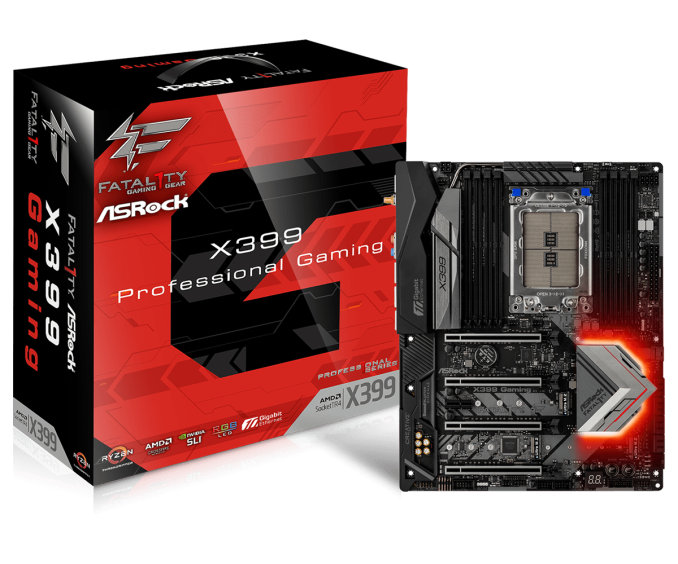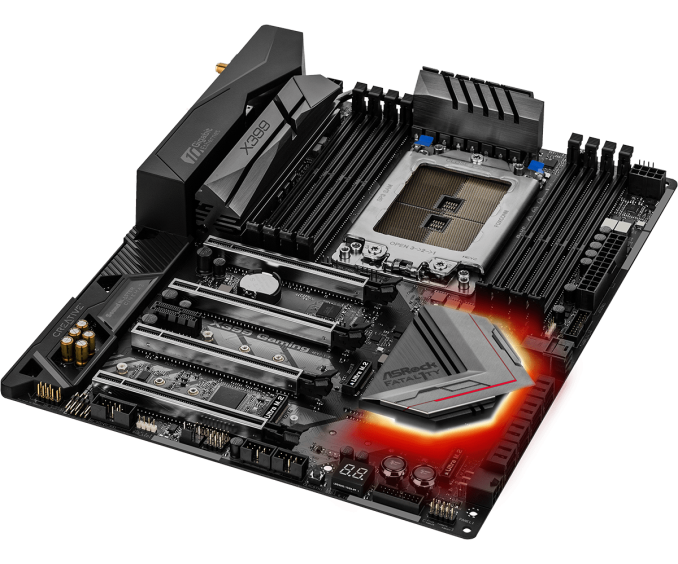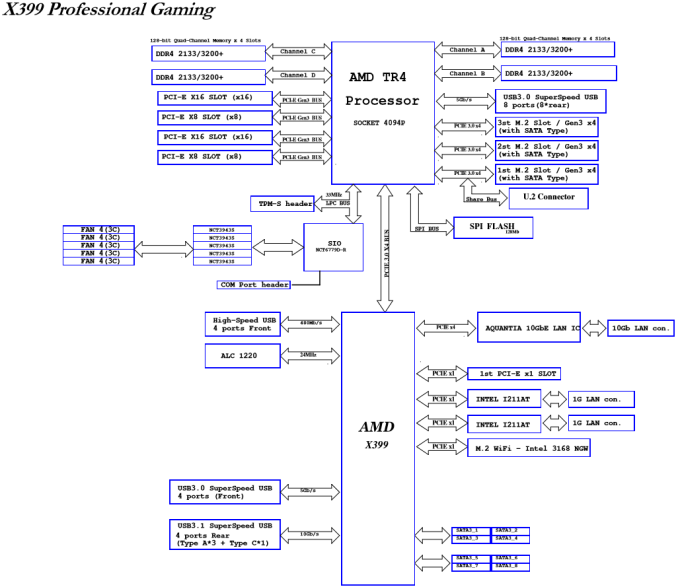An AMD Threadripper X399 Motherboard Overview: A Quick Look at Seven Products
by Ian Cutress & Joe Shields on September 15, 2017 9:00 AM ESTASRock
No stranger to the fray, ASRock is ready with the launch of two boards, the X399 Professional Gaming and X399 Taichi. Both boards share features but have enough differences to separate them in the product stack. The Pro Gaming adds 10 Gigabit Ethernet to its two Gigabit NICs and supports Creative Sound Blaster Cinema 3, while the Taichi aims to be a more mid-range board, by sticking with dual Gigabit NICs and uses Purity Sound 4. The styling is a little different too.
ASRock X399 Professional Gaming
The high-end board from ASRock will be the Professional Gaming. It also carries the Fatal1ty name, due to ASRock’s never-ending association with a pro-gamer from the turn of the century.
On the aesthetic side, the X399 Professional Gaming has a black PCB accented with gray heatsinks and grey stenciling where the M.2 slots are located. The memory slots are black, along with the rear IO cover that extends down the board. There are two heatsinks to cool the VRMs, connected by a heatpipe, and one reaches near to the rear IO. The chipset heatsink is not connected as part of the VRM cooling, but consumes a fairly large portion of the board and looks a bit like a play button. As with the fascination with RGB, the Professional Gaming has a few under the chipset heatsink. Users can add more RGB LEDs via two headers, and control them all through ASRock's RGB LED application.
The Professional Gaming has support for both NVIDIA 4-Way SLI and AMD 4-Way Crossfire with full-length PCIe slots. These have additional reinforcement to prevent sag or bending due to heavy PCIe cards during transit – the reinforcement is what ASRock calls its ‘Steel Armor’. The PCIe slots give an x16/x8/x16/x8 configuration from top to bottom, using 48 of the 60 PCIe lanes from the processor. The rest of the lanes are allocated to storage: there are a total of three M.2 PCIe 3.0 x4 slots, one of which is shared/switched with a U.2 connector. For other storage, there are eight SATA ports from the chipset that natively support RAID 0/1/10.
For added features, the X399 Professional Gaming jumps past the ever-present Gigabit Ethernet and uses an Aquantia AQC107 10 Gigabit LAN controller to appeal to users that want to invest in 10GbE. This is paired with two Intel I211AT network controllers, and all three can do regular gigabit Ethernet duties. If three Ethernet ports were not enough, also included is an integrated Intel AC8265 2x2 802.11a/b/g/n/ac WiFi module, to handle wireless duties.
ASRock provided chipset diagram for the Pro Gaming to show how it breaks down all the bandwidth:
For power delivery, ASRock uses a digital 11 phase International Rectifier solution, along with IR DrMOS for monitoring VRM current and temperature. Distributing power to the VRMs are two EPS 12V connectors, an 8-pin and a 4-pin, although the system will work with only the 8-pin installed. Typically we see EPS connectors oriented close to each other at the top of the motherboard, but here the connectors are located on opposite sides of the socket. As shown above, the 8-pin is in the upper right-hand corner above the DIMM slots, while the supplemental 4-pin is in the more familiar location at the top left-hand corner. ASRock asserts this creates a wider trace for the CPU VRM, bringing better power delivery efficiency and lowering temperatures.
For USB connectivity, the Professional Gaming has three USB 3.1 (10 Gbps) Type-A ports on the rear, one USB 3.1 (10 Gbps) Type-C port on the rear, two USB 3.1 (5 Gbps) headers for front panel ports, and two USB 2.0 headers for front panel ports.
| Fatal1ty X399 Professional Gaming | |
| Warranty Period | 3 Years |
| Product Page | Link |
| Price | $439.99 |
| Size | ATX |
| CPU Interface | TR4 |
| Chipset | AMD X399 |
| Memory Slots (DDR4) | Eight DDR4 Slots, up to 3600 MT/s Supporting 128GB Quad Channel |
| Network Connectivity | 1 x Aquantia AQC107 10 Gigabit LAN 2 x Intel I211AT GbE |
| Wireless Network | 802.11 ab/g/n/ac Dual-Band (2.4/5 GHz) Bluetooth 4.2 |
| Onboard Audio | Realtek ALC1220 |
| PCIe Slots | 4 x PCIe 3.0 (x16/x8/x16/x8) from CPU 2 x PCIe 2.0 x1 from Chipset |
| Onboard SATA | 8 x SATA 6 Gbps Supporting RAID 0/1/5/10 |
| Onboard SATA Express | None |
| Onboard M.2 | 3 x PCIe 3.0 x4 - NVMe or SATA |
| Onboard U.2 | 1 x PCIe 3.0 x4 (disables M2_1 when in use) |
| USB 3.1 | 1 x Type-A , 1 x Type-C (Rear Panel) |
| USB 3.0 | 8 x Rear Panel, 4 x via internal headers |
| USB 2.0 | 4 x via internal headers |
| Power Connectors | 1 x 24-pin ATX 1 x 8-pin CPU 1 x 4-pin CPU |
| Fan Headers | 1 x CPU 1A/12W Max. (4-pin) 1 x CPU Opt/Water Pump 1.5A/18W Max. (4-pin) 2 x Chassis (4-pin) 1 x Chassis Opt/Water Pump 1.(4-pin) |
| IO Panel | 2 x Antenna Ports 1 x PS/2 Mouse/Keyboard Port 1 x Optical SPDIF Out Port 1 x USB 3.1 Type-A Port (10 Gb/s) 1 x USB 3.1 Type-C Port (10 Gb/s) 8 x USB 3.0 Ports 4 x USB 3.0 Ports 3 x RJ-45 LAN Ports w/ LED 1 x BIOS Flashback Switch HD Audio Jacks |
















99 Comments
View All Comments
CityBlue - Saturday, September 16, 2017 - link
The noisy 40mm fan is a major deal breaker for me - what are ASUS thinking by including this? They should add better passive cooling - I don't need the stupid little fan failing or becoming less effective in 2-3 years, leading to random instability.Real shame as my last two motherboards (Intel and AMD) have been from ASUS and I've been really happy, but for Threadripper they're off my list until they design a passively cooled motherboard.
mapesdhs - Tuesday, September 19, 2017 - link
Must admit I quite the look of that Gigabyte Designare-EX, and likewise until now almost all my boards have been ASUS (except for some X58/P55 boards from Asrock, though I have three top-end ASUS P55 boards aswell).I note the absence of EVGA. Have they basically quit the mbd business?
Threska - Sunday, September 17, 2017 - link
Nice, but one deficiency that's carried through a lot of boards is dealing with headers. The writing's tiny. The locations are difficult even if the boards not populated. Documentation a lot of times isn't clear. The one good thing is that it's usually done only once (build time).prisonerX - Monday, September 18, 2017 - link
You need the motherboard equivalent of a large print book.Threska - Monday, September 18, 2017 - link
Endoscope actually, but not everyone has those.msroadkill612 - Saturday, September 23, 2017 - link
A large print, e-atx atx.peevee - Monday, September 18, 2017 - link
Sorry, but $350-550 for a dumb, single-socket, homebound motherboard is insane.satai - Monday, September 18, 2017 - link
What don't you get on "HEDT"?You probably don't need it/don't have money for it. Some people do.
mapesdhs - Tuesday, September 19, 2017 - link
He's either trolling or just ignorant. I know a guy who has MS, got a PhD in a relevant discipline and now does research on his own condition. A TR board would be ideal for the work he does, using lots of GPUs for compute, etc. (biomedical apps) Then there are those who game but also want to stream and encode, and of course solo professionals who can't afford dual-socket XEONs or Opteron-type boards. And plenty of people work at home, so the location of a system at home means nothing. I have a 36-CPU supercomputer in my garage. :Dwiyosaya - Monday, September 18, 2017 - link
The MSI Pro Carbon looks like it has 4 PCI-e 3.0 X16 slots from the diagram in the article. I have to wonder whether those slots are actually electrically X16 slots or some other configuration. I have not been able to find any information on their site or in this article that gives the electrical configuration of those slots. Anyone know for sure?